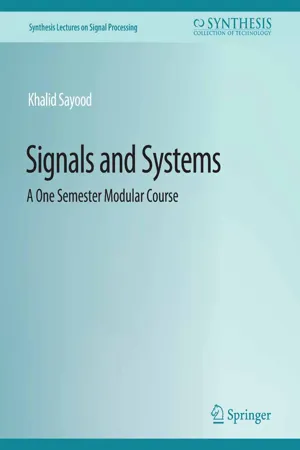
- English
- PDF
- Available on iOS & Android
About This Book
This book is designed for use as a textbook for a one semester Signals and Systems class. It is sufficiently user friendly to be used for self study as well. It begins with a gentle introduction to the idea of abstraction by looking at numbers—the one highly abstract concept we use all the time. It then introduces some special functions that are useful for analyzing signals and systems. It then spends some time discussing some of the properties of systems; the goal being to introduce the idea of a linear time-invariant system which is the focus of the rest of the book. Fourier series, discrete and continuous time Fourier transforms are introduced as tools for the analysis of signals. The concepts of sampling and modulation which are very much a part of everyday life are discussed as applications of the these tools. Laplace transform and Z transform are then introduced as tools to analyze systems. The notions of stability of systems and feedback are analyzed using these tools.
The book is divided into thirty bite-sized modules. Each module also links up with a video lecture through a QR code in each module. The video lectures are approximately thirty minutes long. There are a set of self study questions at the end of each module along with answers to help the reader reinforce the concepts in the module.
Frequently asked questions
Information
Table of contents
- Cover
- Copyright Page
- Title Page
- Dedication
- Contents
- Preface
- Acknowledgments
- 0 What is This Course About
- 1 Complex Numbers
- 2 Functions
- 3 Special Functions
- 4 Classification of Systems
- 5 Linearity and Time Invariance
- 6 Linearity, Time-Invariance, and the Role of the Impulse Response
- 7 Properties of LTI Systems
- 8 Discrete Time Convolution
- 9 Continuous Time Convolution
- 10 Fourier Series
- 11 Fourier Series – Properties and Interpretation
- 12 The Fourier Transform
- 13 Properties of the Fourier Transform
- 14 Some More Useful Properties of the Fourier Transform
- 15 Sampling
- 16 Amplitude Modulation
- 17 Discrete Fourier Transform
- 18 The Laplace Transform – Introduction
- 19 Uniqueness and Linearity of the Laplace Transform
- 20 Laplace Transform – Poles and Zeros
- 21 The Inverse Laplace Transform
- 22 Properties of Laplace Transforms
- 23 Analysis of Systems with Feedback
- 24 Z-Transform
- 25 Region of Convergence for the Z-Transform
- 26 Properties of the Z-Transform
- 27 The Inverse Z-Transform
- 28 Filters and Difference Equations
- 29 Discrete-Time Feedback Systems
- Author’s Biography